The Global Shipping Report
February U.S. Container Imports Continue Strong Performance Amid Trade Tensions
In February 2025, U.S. container imports declined 10% from January, but increased by 4.7% compared to the same month last year. Month-over-month results were expected to be smaller as February was a shorter month by three business days this year and because of the long-standing seasonal decline in container imports from January to February. At 2,238,942 twenty-foot equivalent units (TEUs), however, February 2025 posted the second-highest volume for the month, trailing February 2022 by just 73,341 TEUs.
February imports from China saw a notable decline of 12.5% from January, reaching 872,779 TEUs. This decline may be due to the Chinese Lunar New Year (January 29 – February 12) and fewer business days in the month, in addition to the implementation of a 10% tariff by the U.S. on Chinese imports which went into effect on February 4. Year-over-year, however, volumes from China increased by 7.9% from February 2024, reflecting the continuing demand for Chinese imports. The implementation of a new, additional 10% tariff imposed on March 4, on top of February’s 10% tariff, may create additional volatility for Chinese imports in the months ahead.
Descartes’ March logistics update reports strong performance, even with a typical seasonal softening of U.S. container imports in February 2025 compared to January. The update also highlights the volatility associated with evolving tariff and trade policies on global supply chains. Additionally, potential peace negotiations between Ukraine and Russia, coupled with ongoing geopolitical instability in the Middle East, further complicate the situation. The growing complexity of the global trade landscape suggests supply chain disruptions in the months ahead, creating significant challenges for businesses navigating this unpredictable environment.
In this Article...
- toc
U.S. container imports remain strong even with traditional seasonal decline.
In February 2025, U.S. container import volumes totaled 2,238,942 TEUs, decreasing by 10% over January. (see Figure 1). Compared to February 2024, February 2025 imports increased by 4.7%, indicating continued strength in imports at the start of the year.
Figure 1: U.S. Container Import Volume Year-over-Year Comparison

Source: Descartes Datamyne™
February's import volume was the second highest for the month, trailing February 2022 by just 73,341 TEUs (see Figure 2). The January–February 2025 decline of 248,528 TEUs is closely aligned with the average seasonal month-over-month decrease of 251,266 TEUs observed from 2020 to 2024.
Figure 2: January to February U.S. Container Import Volume Comparison

Source: Descartes Datamyne™
In February 2025, container import volumes at the top 10 U.S. ports dropped by 234,604 TEUs, reflecting an 11.2% decline from January 2025 (see Figure 3). Only two ports saw volume increases: Savannah (up 9.8%) and Charleston (up 10.6%). The remaining ports experienced declines, with the largest reductions at Long Beach (down 24.7%), Los Angeles (down 15.7%), Houston (down 14.9%), and Norfolk (down 11.0%).
Figure 3: January 2025 to February 2025 Comparison of Import Volumes at Top 10 U.S. Ports
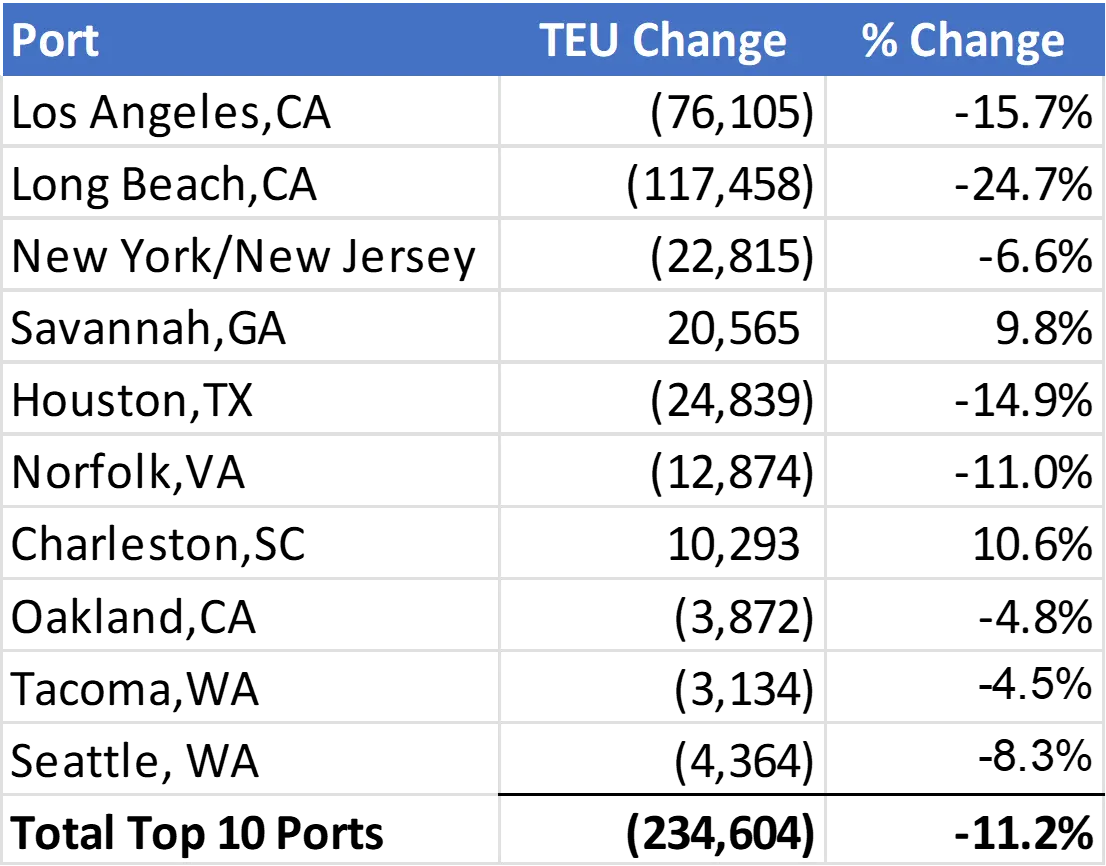
Source: Descartes Datamyne™
U.S. imports from China decline in February 2025 but grow year-over-year.
In February 2025, U.S. import volume from China dropped 12.5% (872,779 TEUs) compared to January (997,909 TEUs). In 2024, Chinese imports declined 10.6% in the same month-over-month period. A seasonal month-over-month decline in Chinese imports is also typical and is not necessarily exclusively indicative of the impact of the new 10% U.S. tariff that took effect in February. Additionally, volumes may have been affected by the Chinese Lunar New Year, which took place from January 29 to February 12, and February being a shorter month. On a year-over-year basis, however, February imports from China were up 7.9%, potentially driven in part by U.S. importers preparing for tariffs. The top three commodity categories (HS-2 codes) for Chinese imports were HS-94 (Furniture, Bedding, etc.), HS-39 (Plastics and Articles Thereof), and HS-84 (Nuclear Reactors, Boilers, Machinery, etc.). China represented 39.0% of total U.S. container imports in February, a slight 1.1% decrease from January and just 2.5% lower than the February 2022 peak of 41.5%.
Figure 4: February 2024–February 2025 Comparison of U.S. Total and Chinese TEU Container Volume Relative to Chinese Import Record
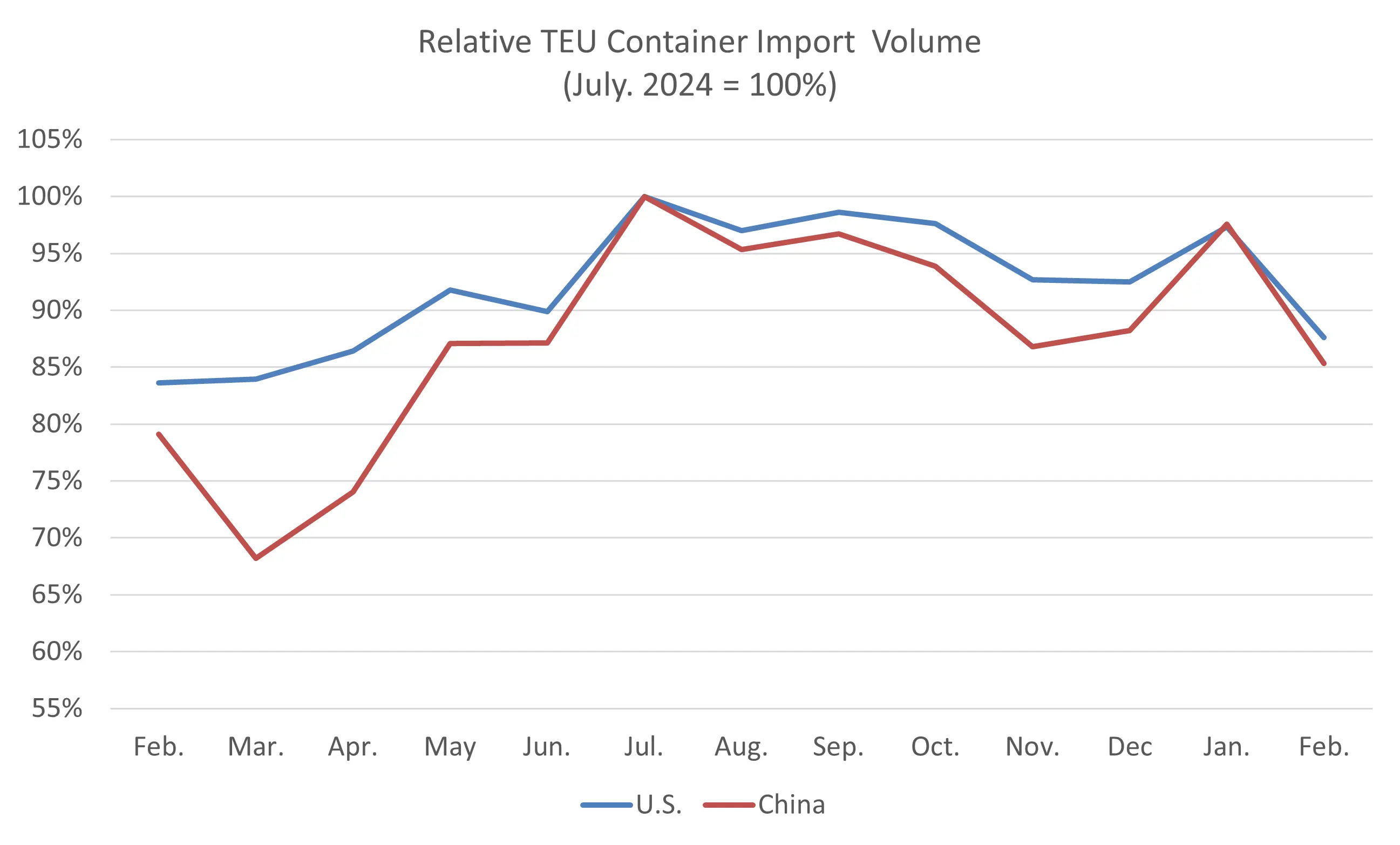
Source: Descartes Datamyne
In February 2025, U.S. container import volume from the top 10 countries of origin (CoO) fell by 201,052 TEUs, a decline of 11.0% compared to January (see Figure 5). Among these countries, China saw the largest drop, down 125,130 TEUs, followed by Vietnam (down 20,964 TEUs), Thailand (down 14,537 TEUs), and Italy (down 11,926 TEUs). The only country in the top 10 to experience an increase was Germany, with a 6.5% gain of 3,094 TEUs.
Figure 5: January 2024 to February 2025 Comparison of U.S. Import Volumes from Top 10 Countries of Origin
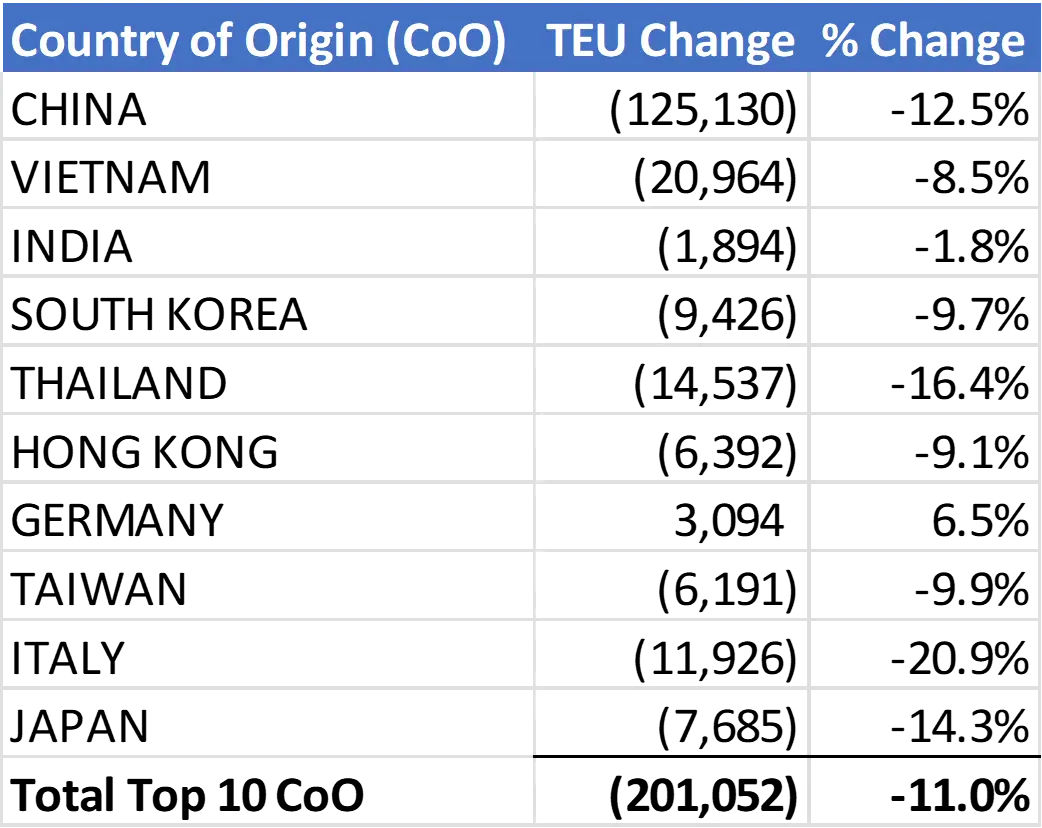
Source: Descartes Datamyne
West Coast ports maintain dominant market share, though gap narrows.
For the ninth consecutive month, the top five West Coast ports maintained their dominance in U.S. container imports, although the gap with East and Gulf Coast ports is shrinking. In February, East and Gulf Coast ports saw a 2.9% increase in market share, rising from 37.7% to 40.6%, while the West Coast's share declined by 4.0%, from 46.8% to 42.8% (see Figure 6). The overall market dominance of the top 10 ports also weakened in February, dropping from 84.5% to 83.4% of total U.S. imports. This shift may reflect, in part, the Chinese Lunar New Year in the first half of February and the February 10% tariff on China.
Figure 6: Volume Analysis for Top Ports, West Coast Ports and East and Gulf Coast Ports

Source: Descartes Datamyne
With a 20% tariff now in effect on U.S. imports from China, however, we may see greater month-over-month fluctuations in market share between top West Coast ports and top East and Gulf Coast ports.
Marginal changes to port delays across West, East, and Gulf Coast ports.
Overall, port transit time delays across the top 10 U.S. ports in February over January remained largely unchanged with marginal increases and decreases in delays (see Figure 7). The largest improvements were at New York where delays were reduced by 1.8 days, Charleston (1.5 days), and Tacoma (1.2 days). The largest increase in delays was at Los Angeles where delays increased by 1.4 days.
Figure 7: Monthly Average Transit Delays (in days) for the Top 10 Ports (Dec. 2024 – Feb. 2025)
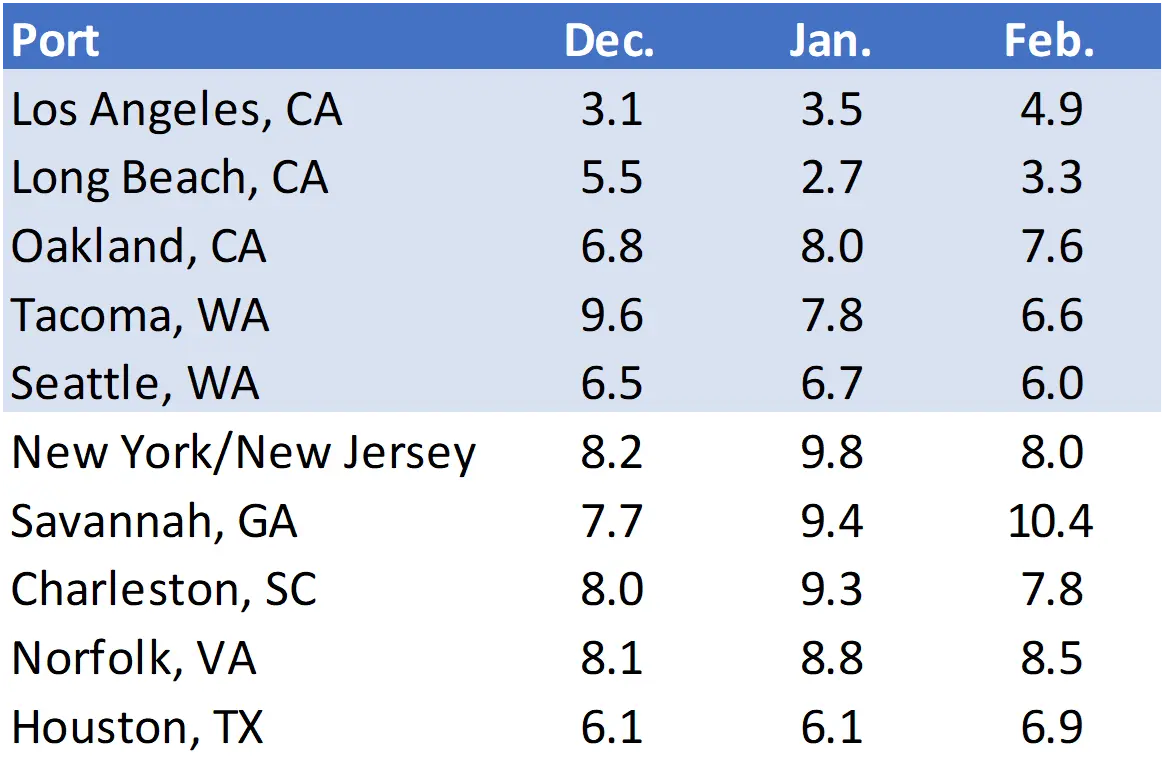
Source: Descartes Datamyne™
Note: Descartes’ definition of port transit delay is the difference as measured in days between the Estimated Arrival Date, which is initially declared on the bill of lading, and the date when Descartes receives the CBP-processed bill of lading data.
Gulf Coast imports hit lowest level since November 2023.
February 2025 Gulf Coast imports (204,421 TEUs) decreased by 10.9% from January (229,403 TEUs), reaching their lowest level since November 2023 (189,491 TEUs) and falling 9.9% below the 12-month average (226,785 TEUs) (see Figure 8). Despite the significant decline in import volumes, port transit times at Gulf Coast ports extended in February, with overall delays increasing by approximately 16%.
Figure 8: March 2024 to February 2025 U.S. Gulf Coast Container Imports
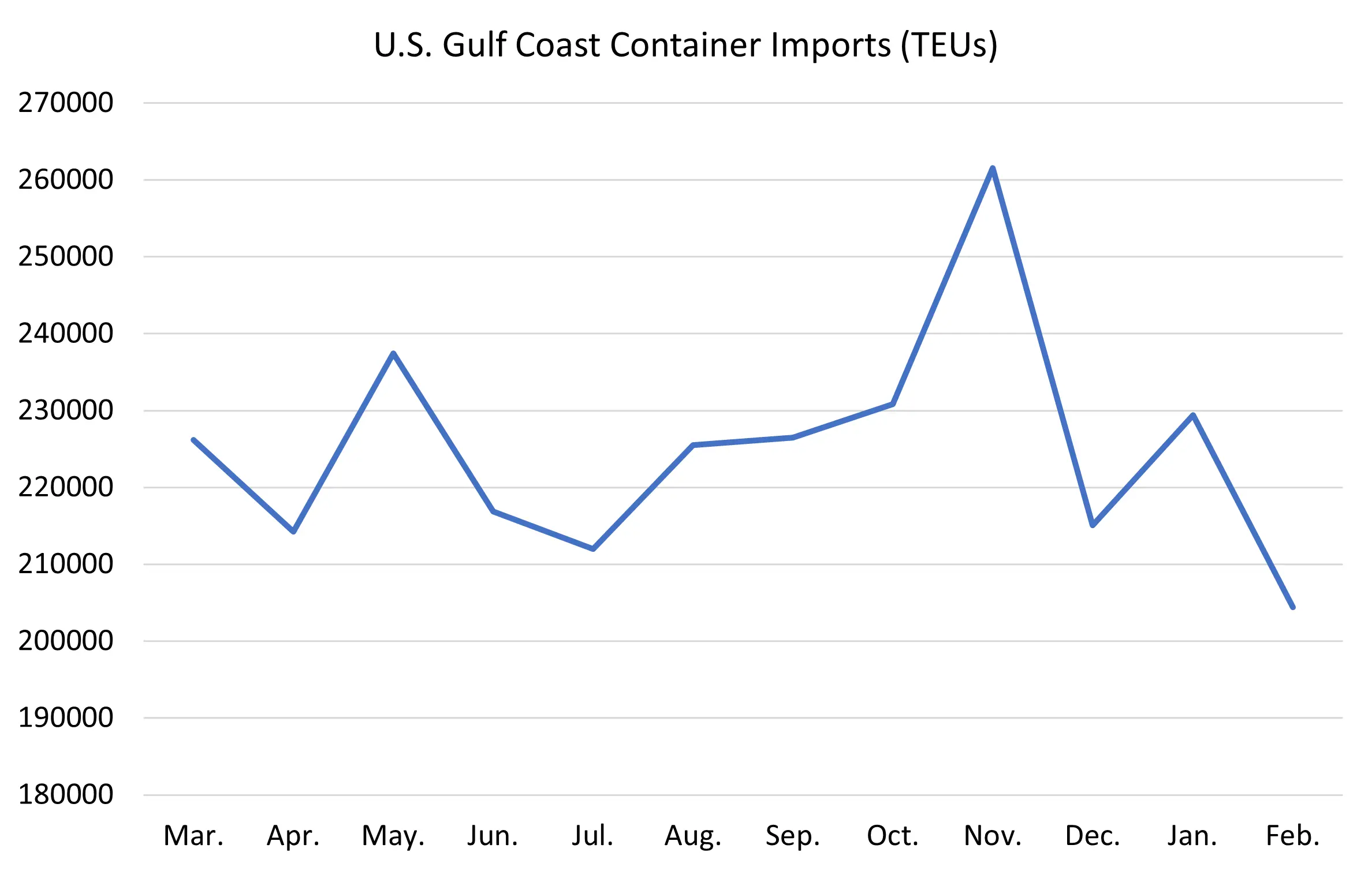
Source: Descartes Datamyne™
Rising trade tensions and tariffs threaten trade and economic stability.
On February 4, the U.S. imposed a 10% tariff on Chinese imports, which was followed by an additional 10% tariff on March 4. While trade negotiations with Mexico and Canada were extended through February, 25% tariffs were applied to U.S. imports on goods from both countries on March 4. On March 6, however, it was announced that Mexico and Canada tariffs were delayed until April 2. These developments create significant uncertainty in global trade, raising concerns about rising import costs, supply chain disruptions, and economic instability. As tensions escalate, businesses and consumers may face higher prices and prolonged market volatility, with the potential risk of an economic recession due to the aggressive tariff policies.
Red Sea shipping stalled despite ceasefire amid ongoing geopolitical risks.
Despite a Houthi-declared ceasefire, Red Sea shipping remains stalled as geopolitical risks persist, deterring companies from resuming transit. No new attacks have been reported, but the region's instability continues to disrupt global trade, raising costs and uncertainty. Experts warn that the ceasefire is fragile and directly tied to the Gaza truce, meaning shipping risks could quickly return if hostilities resume.
To access other articles that track port congestion monthly, visit the
Global Shipping Resource Center
White Papers
Survey Uncovers Supply Chain Strategies of Top Performing Companies
Surviving Peak Season and Beyond: The Essential Guide to Supply Chain Resiliency
The Must-Read Guide on U.S. Maritime Ports

Gain deep insights into 2023 U.S. imports and learn how to mitigate risks in your supply chain.
Stay Informed. Download the Report.
ILA ratifies landmark contract, ensuring labor stability and growth at Atlantic and Gulf Coast ports.
The International Longshoremen’s Association (ILA) has overwhelmingly ratified a new six-year Master Contract Agreement with the United States Maritime Alliance (USMX), securing labor peace at Atlantic and Gulf Coast ports from October 1, 2024 to September 30, 2030. Nearly 99% of ILA members voted in favor of the contract, which includes a historic 62% wage increase, protections against automation, enhanced benefits, and retroactive pay. The agreement strengthens the ILA’s global influence and ensures continued partnership with USMX.
Managing supply chain risk: what to watch in 2025.
In February 2025, U.S. container import volume fell 10.0% from January, dropping below the 2.4 million TEU mark though still showing a 4.7% increase compared to February 2024. Despite the economy continuing to outperform expectations, global supply chains face significant challenges in the months ahead, driven by expanded tariffs on Chinese imports, potential tariffs on Mexico and Canada, and ongoing geopolitical tensions in the Middle East and between Russia and Ukraine. Here’s what Descartes will be closely monitoring in 2025:
- Expanded tariffs and other potential ‘protectionist’ trade policies. Depending on the short- to medium-term priorities of the U.S. administration, broader and deeper tariffs applied to a wide array of goods could compel U.S. importers to significantly re-engineer their supply chains, putting additional pressure on global logistics infrastructure. Imports from China and volumes at West Coast ports did fall during the month. This may stem, in part, from new tariff policies against the country; however, volumes from China were up 7.9% YoY, increasing 63,731 TEUs from February 2024.
- Monthly TEU volumes between 2.4M and 2.6M. This level may stress ports and inland logistics until infrastructure improvements are made. After surpassing 2.4M TEUs in January, February 2025 container imports were 2.2M and volumes did not appear to adversely affect overall port transit time delays at top U.S. ports.
- Port transit wait times. If they decrease, it’s an indication of improved global supply chain efficiencies or that the demand for goods and logistics services is declining. Port transit times in February saw mixed results, with slight increases and decreases across West Coast, East Coast, and Gulf Coast ports.
- The economy. The U.S. is an import-driven economy, so economic health is an important indicator of container import volumes. Following the January Federal Open Market Committee (FOMC) meeting, the Federal Reserve borrowing rate was left unchanged at 4.25% while reported inflation was 2.9%. According to the Bureau of Labor Statistics November employment report, the unemployment rate ticked down to 4.1% while employers added 256,000 jobs. The next FOMC meeting is scheduled for March 18-19.
- Middle East conflict. Houthi attacks have influenced carriers to forego the Suez Canal since the latter half of 2023, raising costs and extending transit times around the Cape of Good Hope. Although the Houthis have declared a ceasefire on vessels in the Red Sea, carriers remain cautious and hesitant to fully resume operations along the trade route. If the Houthi ceasefire is lifted, carriers may once again divert traffic around the Cape of Good Hope rather than reinstating Red Sea passage. So far, the ceasefire has had minimal impact on cargo volumes or transit delays for East and Gulf Coast ports.
Consider recommendations to help minimize global shipping challenges.
In February, U.S. container import volumes were well below 2.4M TEUs, following the typical seasonal decline from January. Meanwhile, the ILA and USMX ratified a new agreement aimed at stabilizing labor at South Atlantic and Gulf Coast ports, reducing the risk of future strikes that could disrupt port operations. The ongoing conflict in the Middle East continues to pressure global supply chains, though a temporary ceasefire in the Red Sea could offer some relief to carriers. The greatest challenge facing global supply chains remains the volatility of trade policies, as the U.S. imposes and threatens more aggressive tariffs on imports, which are expected to disrupt trade flows and reshape the global trade landscape. Descartes will continue to monitor these developments, using Descartes Datamyne along with U.S. government and industry data to provide valuable insights into global shipping trends in the months ahead.
Short-term:
- Consider modelling the impacts of increased tariffs on imported goods and whether a change in sourcing strategy could mitigate potentially higher costs.
- Monitor port volumes and delays to assess trade disruptions if volumes are within 2.4M and 2.6M levels that have historically stressed U.S. maritime logistics infrastructure.
- Track the Middle East conflict as carriers begin to return to the Red Sea as the Houthi ceasefire holds.
- Evaluate the impact of inflation and the Russia/Ukraine and Israel/Hamas conflicts on logistics costs and capacity constraints. Ensure that key trading partners are not on sanctions lists.
Near-term:
- For companies that have cargo moving through the Suez Canal, evaluate the impact of extended rerouting caused by Middle East conflicts.
Long-term:
- Evaluate supplier and factory location density to mitigate reliance on over-taxed trade lanes and regions of the globe that have the potential for conflict. Density creates economy of scale but also risk, and subsequent logistics capacity crisis highlights the downside. Conflicts do not happen “overnight” so now is the time to address this potentially business disrupting issue.
Notes:
1. This report uses the initial compiled release of publicly available U.S. Customs and Border Protection (CBP) Bill of Lading (BOL) data for all U.S. ports, which provides a standard, official source of data for reporting on maritime trade. This data can be subject to modification later by CBP. The modified data can be seen in Descartes Datamyne™ where U.S. maritime records are processed daily. Descartes Datamyne is ISO 9001 certified.
2. In Descartes Datamyne™, twenty-foot equivalent units (TEU) are calculated using a combination of container size and weight as declared on Bills of Lading filed with U.S. Customs and Border Protection (CBP).
How Descartes Can Help
Descartes Datamyne delivers business intelligence with comprehensive, accurate, up-to-date, import and export information.
Our multinational trade data assets can be used to trace global supply chains and our bill-of-lading trade data – with cross-references to company profiles and customs information – can help businesses identify and qualify new sources. Ask us for a free, no obligation demonstration of our data on a product or trade commodity of your choosing – and keep the custom research we create with our compliments.


